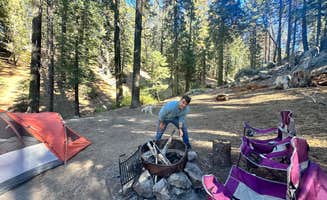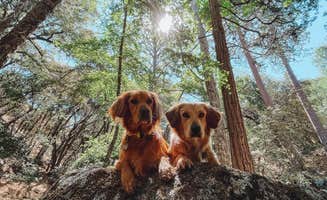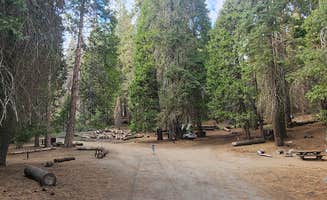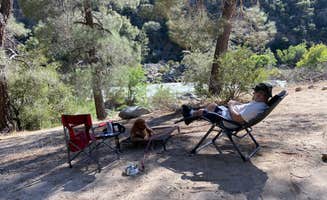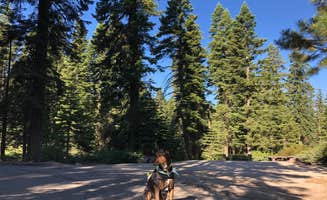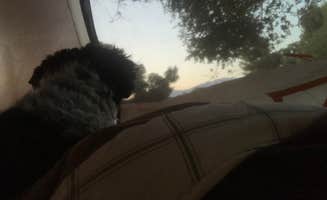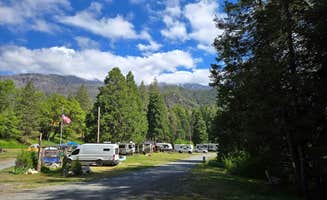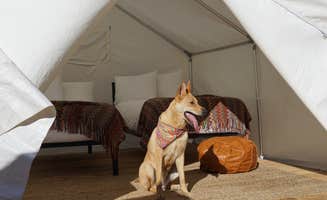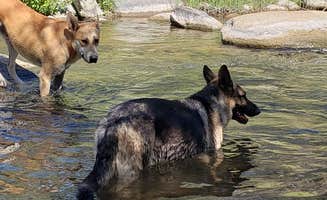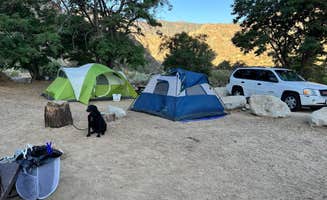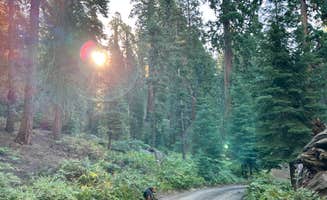Pet-friendly camping spots near Sequoia National Forest range from 3,000 to 7,000 feet in elevation, creating significant temperature variations even during summer months. Dispersed campsites at higher elevations routinely drop below 45°F overnight regardless of daytime temperatures. Most forest roads leading to established campgrounds are paved, while dirt roads to dispersed sites require careful navigation during spring runoff periods.
What to do
Kayaking and rafting opportunities: The Kern River adjacent to Rivernook Campground offers excellent water access. "We stayed on the southern end of the campground site #102 and we walked to the northern end and floated down the river back to our site with a nice cold beer in hand," notes Mike N. The river access points are designated with safety information signs during high water seasons.
Rock climbing at higher elevations: Several climbing routes exist near Dome Rock Dispersed Camping areas. "It's a beautiful area, especially if you want to rock climb or hike with great views, including The Needles," reports Les R. The climbing routes range from beginner to advanced, with detailed information available on Mountain Project website.
Fishing access points: Multiple fishing spots are available directly from campsites. "Great place for RVs and tents. Great fishing spots all over the campground," explains Stacie G. Most fishing locations require California fishing licenses, available at general stores in Kernville or online before arrival.
What campers like
Quick access to Giant Sequoia groves: Campers appreciate the proximity to landmark trees. "It is just a short (very steep) hike from The Wheel Meadow Grove of Giant Sequoias," states Hayley K. about Sequoia National Forest Quaking Aspen Campground. The trail connecting the campground to the sequoia grove is approximately 0.7 miles with significant elevation gain.
Lower crowds at dispersed sites: "I was surprised how vacant this location was. It was absolutely gorgeous and the stars were unreal! There seemed to be a lot of campsites very far from each other," reports Taylor about Dispersed Camp near Sequoia National Park. Most dispersed sites require 4WD or high-clearance vehicles during wet conditions.
Riverside camping options: Several campsites offer direct water access. "On the Kern River. Some spots with great views of the river. Some spacious and wooded," notes Amber D. Water flow varies significantly by season, with spring months often creating unsafe swimming conditions due to snowmelt runoff.
What you should know
Wildlife encounters common: Bears frequent camping areas throughout the forest. "We saw two bears every night so take precaution. They were Cubs, they're not scared of you but also won't mess with you if you lock up all your food," warns Steven R. Bear sightings are most common at dawn and dusk.
Limited water availability: Many sites lack reliable water sources. "There are NO water fill up sites," reports Ryan W. about Redwood Meadow, contrary to some reservation websites. Most dispersed campsites require bringing all water needed for your stay.
Temperature fluctuations: High elevation sites experience significant overnight cooling. "It does get cold here because of the elevation but once the sun comes out it's nice and warm," mentions Jessica P. Pack layers for evenings as temperatures can drop 30-40 degrees from daytime highs.
Tips for camping with families
Look for established campgrounds with amenities: Sites with facilities make family camping easier. "The bathrooms were clean, and the camp host was great too," reports Nicholas G. about Fairview Campground. Most established campgrounds have pit toilets and trash service, though many lack running water.
Consider group camping areas: Some sites accommodate larger family gatherings. "We stayed at one of the group campsites with about 15 people total. Plenty of space and picnic tables," explains Lauren S. Group sites typically require advance reservations and have specific parking limitations.
Check fire restrictions before arrival: Fire rules vary by season and location. "Due keep in mind you will need to obtain campfire permit online before you arrive depending if there are fire restrictions or not," advises Josh S. Fire permits are free and available online from the Forest Service website.
Tips from RVers
Limited hookup availability: Most forest campgrounds lack full hookups. "RV sites start at $37/night and go up depending on the size of your group," notes Mike N. about Limestone Campground. Sites with electric and water hookups fill quickly during peak summer months.
Road access challenges: Many forest roads have limitations for larger vehicles. "Road is bumpy, so drive very carefully, but we saw RVs to get there," reports Pavla L. Most dispersed camping areas are accessed via unpaved forest roads that may be impassable for larger RVs.
Limited dump stations: Plan for limited waste disposal options. Most RV-friendly campgrounds near Sequoia National Forest do not have on-site dump stations. The nearest reliable dump stations are located in Kernville or Porterville, approximately 30-45 minutes from most campgrounds.


